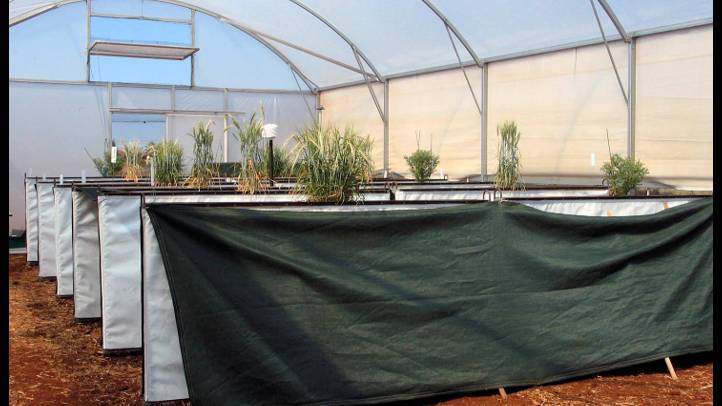Greater drought resilience is being bred into Australia’s wheat crops.
A plant’s genetics can affect its susceptibility to environmental stresses, including to drought, which is becoming a major drag on the world’s food production systems, limiting yield increases and bringing food insecurity ever closer to a critical tipping point.
Breeding for improved yield in dry seasons, however, can lead to something of a paradox: individual genes that improve resilience may also cause yield penalties in good years. These good seasons are when bumper harvests provide the income allowing farm businesses to bridge the increasingly frequent tough years.
Modelling of historical climate data indicates that good years for wheat yields make up just 12 per cent of seasons in Australia’s northern grains region. This creates considerable pressure to earn more in the majority of seasons when crops are water-stressed late in the season, as has occurred in several recent seasons.
However researchers at the Queensland Alliance of Agriculture and Food Innovation (QAAFI) have made a significant breakthrough in defeating the drought tolerance paradox.

Dr Jack Christopher and his team, who are based at the Leslie Research Facility in Toowoomba, Queensland, have developed a technique that better accommodates the genetic complexity needed to breed in wheat resilience to dry conditions, particularly to water stress around flowering, without compromising production in good seasons.
Their approach involves starting with three elite wheat varieties that are popular for their high yield potential in the western, southern and northern grain regions – Mace (PBR), Scout (PBR) and Suntop (PBR), respectively.
They then developed a technique to introduce many subtle genetic differences across the genomes of these elite varieties.
It is this genetic diversity across the network of genes that boosts yield resilience in dry years, but with careful selection can avoid introducing gene combinations that adversely impact yields in the all-important good years.
Dr Christopher says the best of the improved breeding lines has consistently exhibited high yield in trials at 21 sites across Australia. Some lines had a greater than 85 per cent chance of out-yielding the three elite parent varieties in dry years.
He says that extensive field tests indicate that the enhanced lines can reliably lift crop performance in the dry seasons. Prompt uptake by commercial breeders has meant that advanced new wheat varieties with this capability could start reaching growers within a few years.

A genetic basis for greater resilience
Anchoring the innovation achieved by Dr Christopher’s team were prior studies of wheat lines, which yielded 10 to 20 per cent more than standard lines under water-stressed conditions in the northern growing region, at many sites and over many seasons.
The improved yields were associated with two overarching plant characteristics that are based on complex genetics.
The first characteristic is a delay in leaves turning brown and dying (senescing) at the end of a season. This delay allows crops to better complete the process of setting seed and filling grain under dry conditions.
“This delayed senescence is called stay-green. One trait underpinning stay-green in wheat is a delay between flowering and the commencement of leaf browning,” Dr Christopher says. “Field trials indicate that one to two per cent more yield is possible for every day that leaves delay the onset of the browning process, which can add up to 10 per cent higher harvests.”
The second overarching characteristic relates to the architecture of the root systems.
“An advantage in yield and yield stability was observed for plants with root systems that have a narrower overall spread, with less roots to the side, but a greater proportion of the roots directly underneath the plant,” Dr Christopher says.
“These roots were growing deep into the soil where they can tap into reserves of moisture late in the season.”
The underlying genetics, however, have made the traits too complex for routine use by commercial wheat breeders.

Breakthrough breeding
To get around this problem, Dr Christopher’s team crossed the elite varieties that are favoured by growers with up to 12 additional parents that served as donors of the stay-green and narrower root spread.
This produced genetically related lines collectively called a ‘multiple reference parent (MR) nested association mapping’ (NAM) population.
Facilitating this intensive pre-breeding work was the speed breeding technique, which allowed the development of the MR-NAM population in just 18 months, producing over 1500 inbred lines. Conventional crossing allowing only one new generation a year could have taken decades.
Extensive field-testing was then used to rate the population’s performance under real-world growing conditions. Lines were also examined for their stay-green in the field while root spread was tested in the laboratory.
Some of the best performing MR-NAM lines were passed on to commercial breeding companies in 2017 and have now progressed to advanced variety trials in at least one commercial breeding program.
To further boost performance, Dr Christopher’s team additionally crossed some of the best-performing MR-NAM lines together to combine even more root and stay-green genetics into the elite varieties.
This more advanced germplasm was made available to breeders for the first time in 2019.
Moving forward, the MR-NAM population now provides a gateway for the rapid transfer of additional traits into this elite material or into newer elite backgrounds.
Already, QAAFI researchers are setting their sights on donors that can provide enhanced heat tolerance and additional water-use efficiency traits based on transpiration biology.
This project is funded by the University of Queensland, the Department of Agriculture and Fisheries Queensland and the Grain Research and Development Corporation.
Contact: Dr Jack Christopher, Senior Research Fellow, Centre for Crop Science, Queensland Alliance for Agriculture and Food Innovation, The University of Queensland. T. +61 7 4529 1413 M. 0434 609 152 or E. j.christopher@uq.edu.au
Photos contact: Carolyn Martin, QAAFI Communications M: 0439 399 886 E: carolyn.martin@uq.edu.au
Related article: GRDC Groundcover article by Gio Braidotti, Plant breeders make gains in wheat's resilience to terminal drought, published 23 March 2020.



